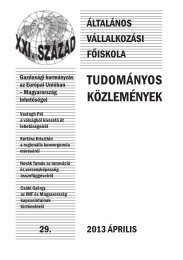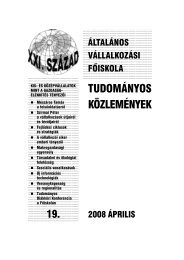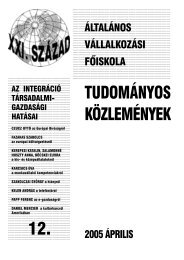Tudástársadalom, vállalkozások, Európa - Ãltalános Vállalkozási ...
Tudástársadalom, vállalkozások, Európa - Ãltalános Vállalkozási ...
Tudástársadalom, vállalkozások, Európa - Ãltalános Vállalkozási ...
Create successful ePaper yourself
Turn your PDF publications into a flip-book with our unique Google optimized e-Paper software.
12345678901234567890123456789012123456789012345678901234567890121234567890123456789012345678901212345678901234567890123123456789012345678901234567890121234567890123456789012345678901212345678901234567890123456789012123456789012345678901231234567890123456789012345678901212345678901234567890123456789012123456789012345678901234567890121234567890123456789012312345678901234567890123456789012123456789012345678901234567890121234567890123456789012345678901212345678901234567890123102123456789012345678901234567890121234567890123456789012345678901212345678901234567890123456789012123456789012345678901231234567890123456789012345678901212345678901234567890123456789012123456789012345678901234567890121234567890123456789012312345678901234567890123456789012123456789012345678901234567890121234567890123456789012345678901212345678901234567890123Cost benefit analysis (CBA)The EU only supports projects that are also useful on a national, community level, and are economicallylucrative.Of course, it does not mean that they must produce a financial return. We come across severalcases that, though not yielding a profit, are useful both on a national and a community level. However, inevery single case an essential requirement is that they should be viable in the long term. In the costbenefit analysis we analyse the economic and social costs and benefits. Besides the costs and benefitsinvolved in financial planning, it also comprises values that were not included as externalities (externaleconomic effects) and indirect effects (environmental and social effects). Usually it is justified to usemore indicators simultaneously as the application of just one indicator does not provide relevantinformation as to the success of the project to be implemented.The ratio of the discounted costs and benefits of a project (B/C)B/C = PV (h) / PV (k)PV (h) (discounted benefits and positive effects)PV (k) (discounted costs and negative effects)Determining the discount rate used for the conversion to the present time of monetary movementsoccuring at different times is based on the alternative cost of capital. In the period 2006-2007 the ratewith a real value of 6 pc was considered as a preference parameter. The project is worth implementingprovided the indicator exceeds 1.Economic discounted net present value (ENPV)ENPV = Σ [(PV (h) – PV (k)] nENPV (economic discounted net present value)PV (h) (discounted benefits and positive effects)PV (k) (discounted costs and negative effects)n (years)The economic discounted net present value is the differential between the gains and costs arisingduring the project life cycle. As the costs typically arise at the beginning of the investment, while the gainsare only produced in the later years, the time length and the value of the discount rate have outstandingsignificance. The investment is worth implementing if the value is positive.Economic internal rate of return (ERR)ENPV = 0 = Σ[(h-k)/ (1+ERR)] nh (benefits and positive effects)k (costs and negative effects)ERR (economic nternal rate of return)The economic internal rate of return shows how big is the maximum return on capital below whichthe investment is worth implementing.









